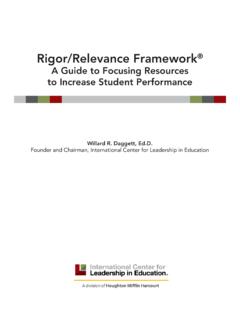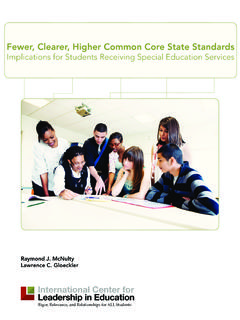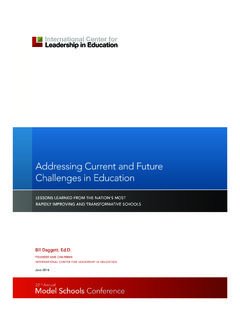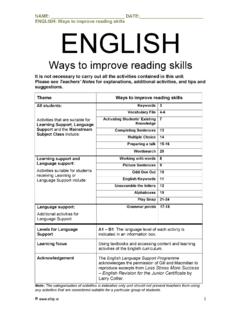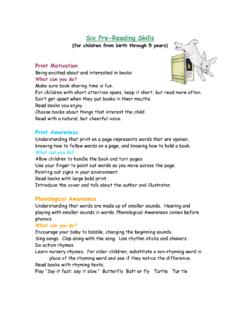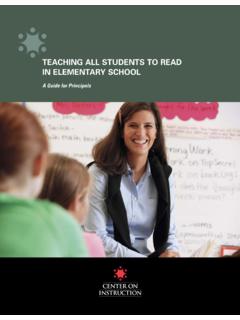Transcription of Reading Skills and the Career Readiness Gap - ICLE
1 Reading Skills and the Career Readiness GapA Study of High School Students Preparedness for College and Career Willard R. Daggett, and Chairman, International Center for Leadership in Education and the Successful Practices NetworkJerry A. Pedinotti, President and Lead Research Analyst, Tipping Point AnalyticsCopyright July 2014, September 2016 by International Center for Leadership in Education, a division of Houghton Mifflin Harcourt. All rights reserved. 1 Reading Skills and the Career Readiness Gap A Study of High School Students Preparedness for College and Career The world we live in continues to evolve and shows no signs of slowing down. What the future holds in terms of academics or jobs is uncertain and barely imaginable. Educators cannot assume that the traditional focus on college preparation or specific job training will be enough to prepare our students for what may lie ahead; our research has shown that it is not enough.
2 In fact, life outside of school requires substantially higher levels of Reading proficiency than most students experience in the high school classroom and even in post-secondary education. The best option we have is to redefine and restructure teaching and learning in ways that equip students to deal with the unexpected and adapt to changing circumstances. This will involve a level of retraining, not only in terms of professional development for teachers, but also in the entire school community s shift in culture. States definition of Reading proficiency needs to account for not just traditional academic measures of Reading competence, but also the Skills that make individuals employable and successful in their lives beyond high school. The implementation of the higher state standards, new assessments and evaluation of educator effectiveness has reenergized the focus to ensure that students are both college and Career ready.
3 To help create an understanding of and establish necessary proficiency levels within the standards, the International Center for Leadership in Education and the Successful Practices Network commissioned the CTE Technical Assistance Center (CTE TAC) of NY and Tipping Point Analytics (TPA) to conduct a study to determine how the literacy requirements for 11th and 12th grade high school students compare to the text demands that a typical entry-level employee would encounter during his or her first year on the job. Previous studies have examined a wide-ranging sample of texts from both academic and non-academic environments. Prior iterations of this study highlighted the literacy challenge that high schools face: the literacy requirements of adults in their daily life, entry-level employees, first-year post-secondary students, and people in the military are significantly higher than the required levels of Reading proficiency that most high school students experience.
4 The primary focus of the most recent national literacy study, concluded in 2014, was to see whether or not the literacy requirements for entry-level jobs have changed over time. Technology and innovations in the global economy change constantly. Likewise, the texts that people in the workplace need to be able to read and understand are shifting and more so than in academic areas, which remain relatively static. Inspections of literature and textbooks used now and in the past as instructional materials in schools and colleges have confirmed this. This report contains the Reading complexity measures, reported as Lexiles , of all submissions that were received and analyzed. Personal use or job-specific texts that were not written with standard sentence and paragraph structure could not be measured.
5 However, this was not a common occurrence. Copyright July 2014, September 2016 by International Center for Leadership in Education, a division of Houghton Mifflin Harcourt. All rights reserved. 2 The Literacy Gap Student learning styles, interests, and aptitudes are like fingerprints: no two are the same. In a classroom situation where a teacher is lecturing or the students are Reading a passage from a textbook, it can be assumed that only a fraction of the students are experiencing the appropriate amount of instructional material for the lesson to be effective. Students who find the lesson too rigorous become lost and discouraged while other students may not be challenged enough and become bored. Some students may have no interest in the lesson whatsoever.
6 Ideally, each student will experience measurable and sustained improvement from class to class, day to day, and grade to grade. By the time a student graduates from high school, he or she will have gained the requisite Skills to succeed in the next stage of life, whether it is college or in a Career . If a student can step seamlessly into that next phase, then the education system has worked for that individual. If all students can make that transition, then the system on the whole is succeeding. But this is not reality. Since the publication of A Nation at Risk in 1983, which concluded that American schools were not preparing high school students for their next stage of life after graduation, the impetus for change has come primarily from pressure placed on elected officials by the business community and not from higher education, whose own slipping standards allowed for more and more developmental English courses to backfill academic deficiencies among entering freshmen.
7 Business and industry continue to feel firsthand the Skills gap between what students are achieving in school and what they actually need in order to be successful in today s workplace. The business community has long identified inadequate Reading ability as a leading problem among entry-level employees. In the past, many secondary school educators attempted to solve the problem by assigning more Reading , which was mostly prose. The problem with this is twofold: 1. Prose is not read in most workplace environments. Literacy, in the context of work, requires better technical Reading Skills for understanding informational documents and quantitative material. Students need to be exposed to a variety of texts, not just from other content areas, but from Career and technical education courses, personal-use or adult-roles texts, and sample occupational materials.
8 The modern definition of literacy needs to encompass all three types of text: prose, document, and quantitative. Too often, it is material quantitative in nature that is missing from a student s educational experience. 2. Assigning more Reading will not usually result in higher Reading proficiency. A student at a certain Reading level will not improve his or her proficiency unless he or she is continually challenged by the text. A student that reads a text written at or below his or her Reading level is not being challenged. Conversely, a student presented with a text well above her or his Reading level will find it too complex and grow frustrated. A text needs to be slightly above a reader s ability level to challenge the student and promote growth in Reading proficiency.
9 Every state in the country, whether or not it has adopted some form of the Common Core State Standards, has added the requirement of College and Career Ready to its standards. The shift to include college AND Career Readiness has been both intentional and consequential. Copyright July 2014, September 2016 by International Center for Leadership in Education, a division of Houghton Mifflin Harcourt. All rights reserved. 3 Traditionally, College Prep has been seen as a rigorous educational program. Career ready was seen as a relevant but not necessarily rigorous education experience. College AND Career ready needs to be both rigorous and relevant. Therefore, transitioning from the traditional paradigm of college OR Career ready to college AND Career ready for all students requires a very different set of Skills and abilities.
10 In the past, college ready meant collecting or accomplishing a series of academic merits ( , Carnegie units, AP courses, ACT or SAT scores), whereas Career ready focused on acquiring technical Skills , participating in a CTE program, or working toward a certification. With either focus, students were placed on markedly different paths with no guarantee of success. The challenge we are faced with today is ensuring that the factors that make students successful in college and careers are the same: the ability to learn and apply new information, problem solve, communicate and collaborate with peers, and contribute to the greater good of society. If we can focus on teaching and then measure these more broadly defined characteristics it will be a better indicator of whether a graduate is truly prepared for a successful life after high school.
